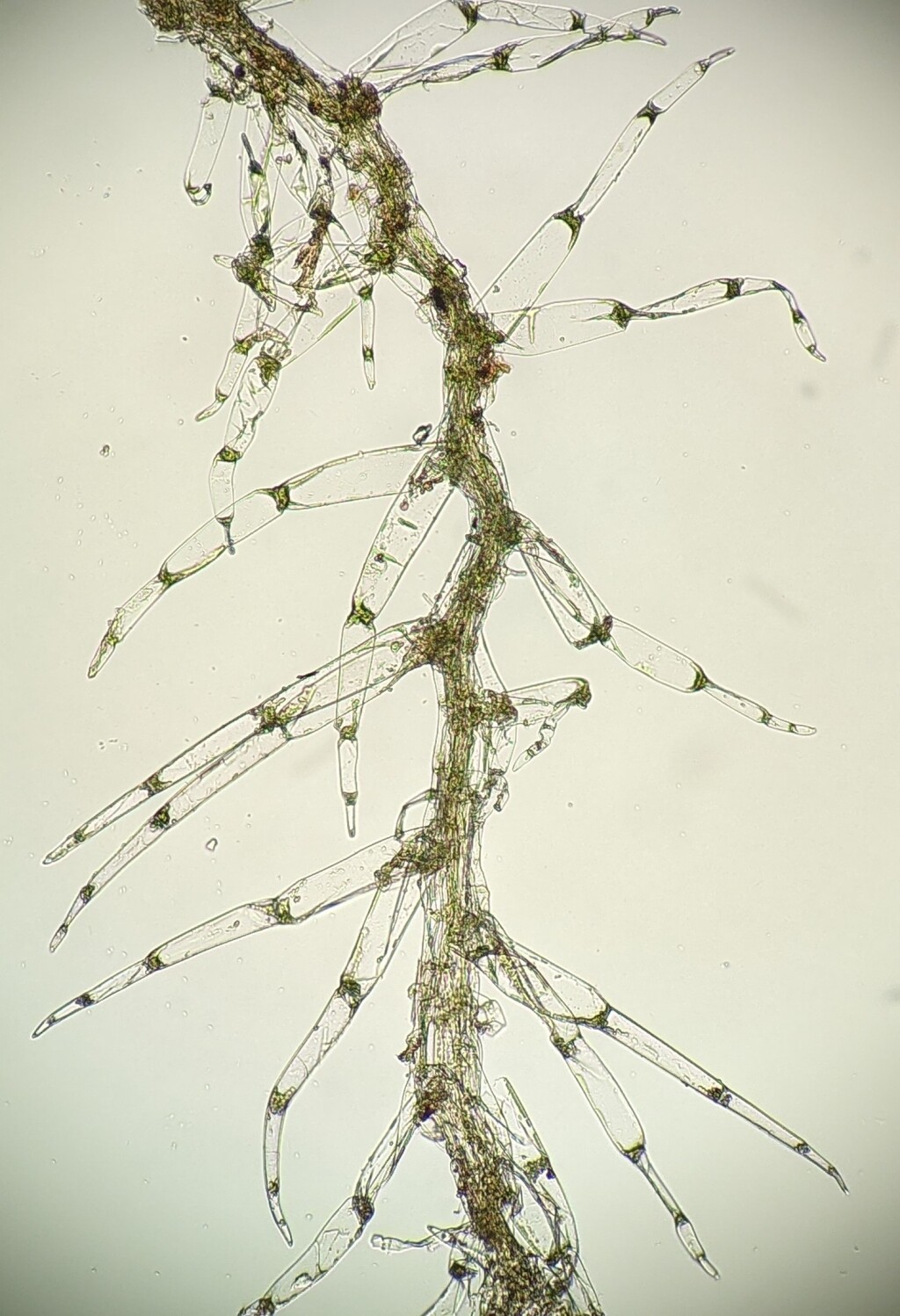Telaranea
Terrestrial, lithophytic or epiphytic, dioicous or autoicous (not in Victoria), light or whitish green, usually glistening. Asexual reproduction rarely by caducous terminal lobe cells (not in Victoria). Stems creeping, delicate, irregularly branched; branches emerging from main stem on ventral side and with a collar of tissue at base, emerging near abaxial side of lateral leaf with one lobe and without a collar of tissue at base, or rarely emerging beside an underleaf with fewer lobes and without a collar of tissue at base (not in Victoria). Leaves comprising usually 2 lobes, rarely 3–5 lobes, fused by the basal cell of each lobe, or reduced to single one of these lobes (not in Victoria), incubous to transverse, widely spreading away from stem, distant to contiguous; lobes filiform to setaceous, sometimes appearing moniliform (not in Victoria), composed of a single series of 2–14 cells, equal or unequal (not in Victoria), divergent. Underleaves two basal cells each bearing a slime papilla at apex, with 2–4, rarely 5 (not in Victoria) lobes, each to 3 cells long and fused by the basal cells or rarely with a disc 2 cells long (not in Victoria), or asymmetric with a basal cell and an apical slime papilla forming one half, the other half formed by 3–5 elongated cells (not in Victoria). Leaf cells rectangular or oblong, shorter when terminating lobe, smooth, thin- or firm-walled, with 2–6 oil bodies; oil bodies ellipsoid, fusiform or ovoid, granular or finely botryoidal, grayish. Rhizoids fascicled from underleaf cells or from the penultimate lobe cell (not in Victoria). Androecia terminating leafy axes or forming short branches emerging from ventral stem, with 6–25 pairs of bifid or rarely trifid (not in Victoria) bracts, each with a single antheridium. Sporophyte terminating short ventral branch, without normal vegetative leaves but subtended by highly differentiated bracts and developing within a perianth; bracts with 2–4 acuminate or setaceous lobes, with a distinct disc; perianth cylindric to conic, terete at base becoming trigonous toward mouth where lobulate-ciliate; capsule ellipsoid, 2–3-stratose; elaters bi- or rarely trispiral (not in Victoria); spores areolate or granulate-vermiculate (not in Victoria), pale or yellow-brown.
Thirty-three species mostly in South America, but also in the Caribbean, South Africa to tropical Africa, Madagascar, the Seychelles, Malesia, New Caledonia, Fiji, New Zealand, south-east Australia, and extending north to eastern North America, Macaronesia, the Azores, Spain and Ireland (Schuster 2000; Söderström et al. 2016); one species, T. herzogii (E.A.Hodgs.) E.A.Hodgs., in Victoria.
The circumscription of Telaranea presented here matches that given in Söderström et al. (2016) and differs significantly from traditional circumscriptions e.g. Schuster (2000). The Neotropical and Malesian Arachniopsis Spr. is included in the modern circumscription of Telaranea presented here. Features used to traditionally distinguish the two genera, such as a lack of Frullania-type branching (from below a lateral leaf with fewer lobes and without a collar of tissue at base) and a lack of underleaves in Arachniopsis, has since been found in Arachniopsis (Schuster 2000; Engel & Smith Merrill 2004) and at least one of Arachniopsis species is closely related to Telaranea in phylogenies of DNA sequences (Cooper et al. 2011). It is possible that Amazoopsis J.J.Engel & G.L.Merr., that also appears to be closely related to Telaranea (Cooper et al. 2011), should also be subsumed into Telaranea. In contrast, many of the species previously included in Telaranea, including many Australian species, have now been placed in separate genera, such as Ceramanus, Neolepidozia and Tricholepidozia, based on these genera being closer related to Lepidozia than they are to Telaranea in phylogenetic analyses of DNA sequences from all genomic compartments (Cooper et al. 2011, 2012).
Cooper, E.D., Shaw, A.J., Shaw, B., Henwood, M.J., Heslewood, M.M. & Brown, E.A. (2011). A multi-locus molecular phylogeny of the Lepidoziaceae: Laying the foundations for a stable classification. Molecular Phylogenetics and Evolution 59: 489–509.
Cooper, E.D., Henwood, M.J. & Brown, E.A. (2012). A molecular phylogeny of the Lepidozia generic complex supports re-circumscription of the Lepidozioideae. Molecular Phylogenetics and Evolution 65: 10–22.
Engel, J.J. & Smith Merrill, G.L. (2004). Austral Hepaticae. 35. A taxonomic and phylogenetic study of Telaranea (Lepidoziaceae), with a monograph of the genus in temperate Australasia and commentary on extra-Australasian taxa. Fieldiana, Botany 44: 1–261.
Schuster, R.M. (2000). Austral Hepaticae Part I. Nova Hedwigia Beiheft 118. Cramer in der Gebrüder Borntraeger Verlagsbuchbehandlung: Berling & Stuttgart.
Söderström, L., Hagborg, A., von Konrat, M., Bartholomew-Began, S., Bell, D., Briscoe, L., Brown, E., Cargill, D.C., Costa, D.P., Crandall-Stotler, B.J., Cooper, E.D., Dauphin, G., Engel, J.J., Feldberg, K., Glenny, D., Gradstein, S.R., He, X., Heinrichs, J., Hentschel, J., Ilkiu-Borges, A.L., Katagiri, T., Konstantinova, N.A., Larraín, J., Long, D.G., Nebel, M., Pócs, T., Puche, F., Reiner-Drehwald, E., Renner, M.A.M., Sass-Gyarmati, A., Schäfer-Verwimp, A., Moragues, J.S., Stotler, R.E., Sukkharak, P., Thiers, B.M., Uribe, J., Váňa, J., Villarreal, J.C., Wigginton, M., Zhang, L. & Zhu, R. (2016). World checklist of hornworts and liverworts. Phytokeys 59: 1–828.
 Spinning
Spinning